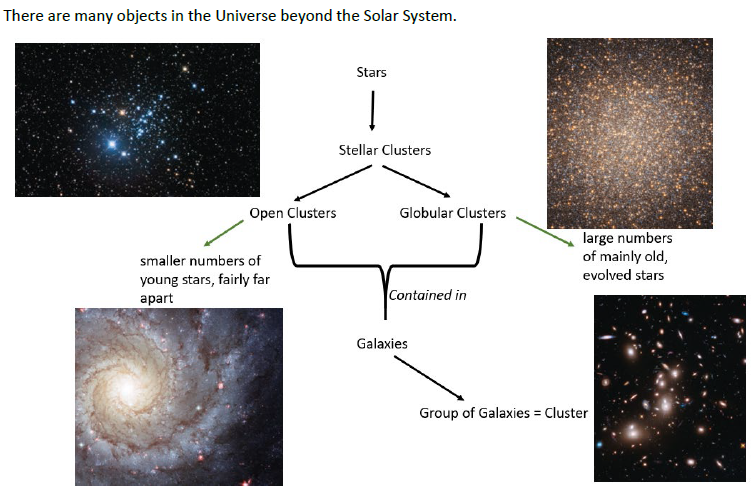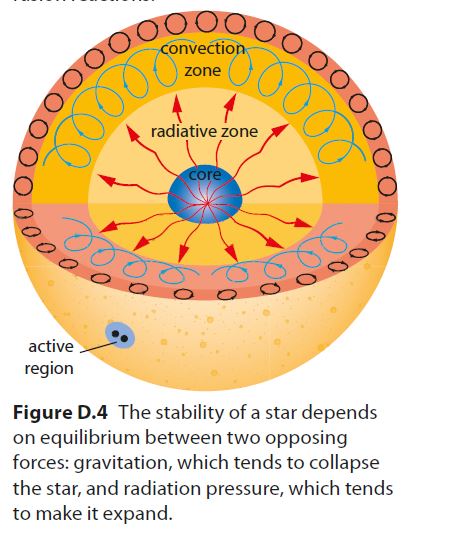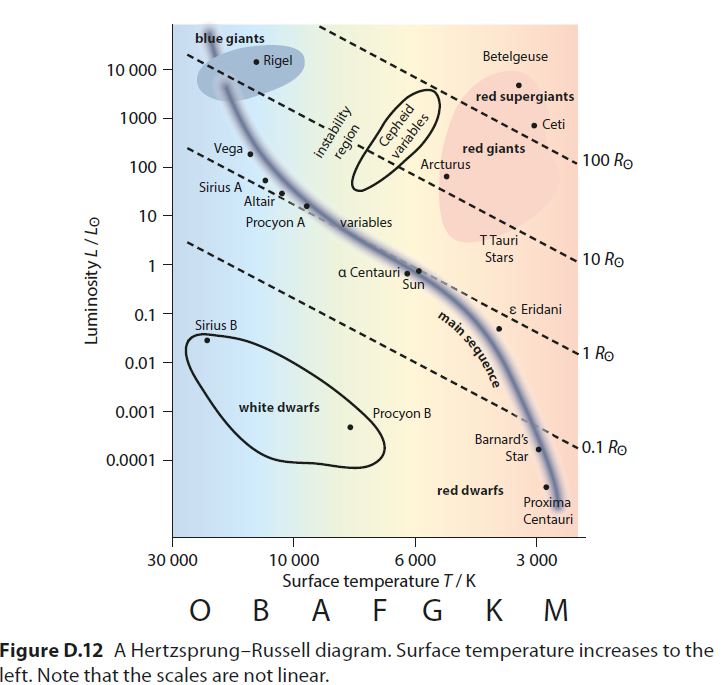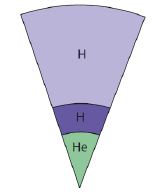Topic D- Astrophysics
1/41
Earn XP
Description and Tags
D.1- Stellar Quantities, D.2- Stellar Characteristics & Stellar Evolution, D.3- Cosmology
Name | Mastery | Learn | Test | Matching | Spaced |
|---|
No study sessions yet.
42 Terms
Light Year and Astronomical Unit
Light year- distance that light travels in a year
AU- estimate of the distance from Earth to the Sun and approximately equal to 150 million kilometres
D1.1 Stars
Single Star: a ball of gas that undergoes nuclear fusion (don’t orbit anything, held together by its own gravity)
Binary Star: Two stars orbiting a common centre
* All planets revolve around the sun in the same direction
* **globular clusters:** large clusters of mainly old evolved stars
* **open clusters: a** smaller number of younger stars that are further apart
* **galaxies (in both clusters):** a large number of stars and stellar clusters
* **superclusters:** clusters of galaxies
\
(each diagram/dot point is further out in space)

D1.1 Galaxy
A collection of a very large number of stars mutually attracting one another through the gravitational force and staying together.
The number of stars in a galaxy varies from a few million in dwarf galaxies to hundreds of billions in large galaxies. It is estimated that 100 billion galaxies exist in the observable universe
* radiation and gravity

* *1 light year= 9.46 x 10^15m* (formula booklet)
* *Average distance between stars= 1 pc (parsec)*
* *4.2 ly=1.3 pc*
* *Distance of parsec= 1/p(parsec)*
\
(measured in radians)
\
or *parsec= 1/p* (in arc seconds)
* stars are assumed to radiate similar to black bodies
D1.5 Luminosity Formula
L = σAT^4
AREA= surface area of a star therefore 4pie r squared
(in formula booklet)
\
(in formula booklet)
\
the relationship wave length of maximum intensity radiation of a star and its temperature
* OBAFGKM
\
(O is blue (hottest) ---→ M is Red (coldest))
\
Acronym: oh be a fine girl kiss me

\
supergiant= just bigger
\
Formula: *L (fish) M^3.5*
D2.7 Why a Cepheid Star Varies in Luminosity
The reason for a periodic variation is the periodic expansion and contraction of the outer layers of the star
if asks about size- relates to surface area of outer layer
Process:
periodic relationship in size from outer layers
leads to periodic increase in temperature
then periodic increase in luminosity
\
(basically they come before normal stars)
* heavier stars take less time
* Only hydrogen in the inner shell undergoes nuclear fusion to helium

* less than 1.4 it becomes a white dwarf
* 2-3 it collapses and forms a neutron star
D3.1 HUBBLES LAW
States that the velocity of recession is directly proportional to the distance (d) between the Earth and the galaxy’s velocity (v) of recession.
v=Hod
Ho=hubble’s constant
doppler effect indicates galaxies are moving away from us. Which proves there are red-shifted absorption lines
D3.2 Cosmic Scale Factor R + Red Shift
The expansion of the universe can be described with the scale factor, R. This is the difference in coordinates of ∆x by R gives the physical distance between to point
d=R∆x
D3.3 Big Bang Model
The Big Bang theory states that both space and time originated with the expansion from a singularity.
The evidence that supported the Big Bang theory was observed through the redshift (Doppler effect) of almost all the galaxies. This indicates that all of the galaxies are moving away from us.
D3.3 Evidence to Big Bang Model
The early universe was in thermal equilibrium and the radiation from then had a black body spectrum, which has traveled through space, becoming increasingly redshifted up to this point in time. This reduces the temperature of the black body spectrum and the radiation should be visible from every point in space.
As the radiation travels throughout the universe, space has expanded, causing the wavelength to increase and its energy to decrease.
D3.4 CMB (Cosmic Microwave Background)
The discovery of the CMB (Cosmic Microwave Background) led to the Big Bang theory becoming the currently accepted model since it is not supported by the Steady State theory
The CMB is a type of electromagnetic radiation which is a remnant from the early stages of the Universe
It has a wavelength of around 1 mm making it a microwave, hence the name Cosmic Microwave Background
D3.5 Accelerating Universe and Red-Shift
The evidence for an accelerating expansion comes from observations of the brightness of distant supernovae. We observe the redshift of a supernova which tells us by what the factor the Universe has expanded since the supernova exploded. This factor is (1+z), where z is the redshift. However, in order to determine the expected brightness of the supernova, we need to know its distance now. If the expansion of the Universe is accelerating due to a cosmological constant, then the expansion was slower in the past, and thus the time required to expand by a given factor is longer, and the distance now is larger. But if the expansion is decelerating, it was faster in the past and the distance now is smaller. Thus for an accelerating expansion, the supernovae at high redshifts will appear to be fainter than they would for a decelerating expansion because their current distances are larger.